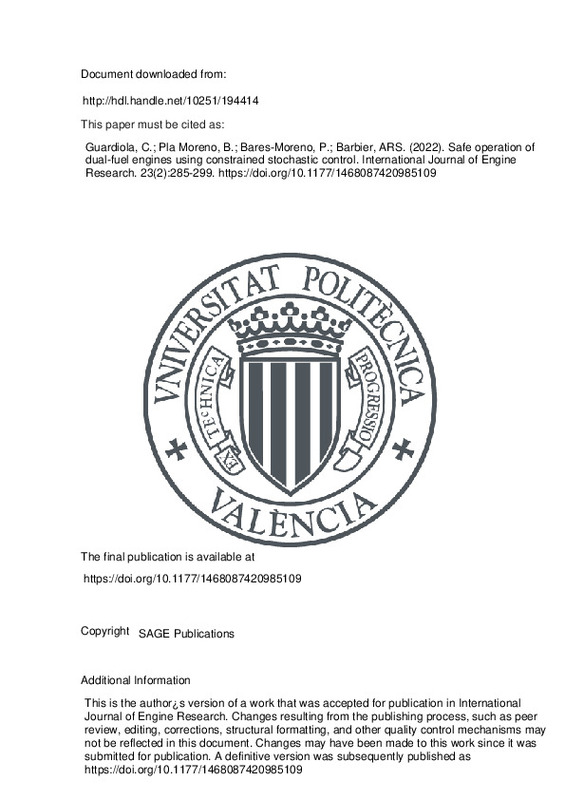Guardiola, C.; Pla Moreno, B.; Bares-Moreno, P.; Barbier, ARS. (2022). Safe operation of dual-fuel engines using constrained stochastic control. International Journal of Engine Research. 23(2):285-299. https://doi.org/10.1177/1468087420985109
Por favor, use este identificador para citar o enlazar este ítem: http://hdl.handle.net/10251/194414
|
Título:
|
Safe operation of dual-fuel engines using constrained stochastic control
|
|
Autor:
|

 Guardiola, Carlos
Guardiola, Carlos

 Pla Moreno, Benjamín
Pla Moreno, Benjamín

 Bares-Moreno, Pau
Bares-Moreno, Pau

 Barbier, Alvin Richard Sebastien
Barbier, Alvin Richard Sebastien
|
|
Entidad UPV:
|
Universitat Politècnica de València. Departamento de Máquinas y Motores Térmicos - Departament de Màquines i Motors Tèrmics
Universitat Politècnica de València. Escuela Técnica Superior de Ingenieros Industriales - Escola Tècnica Superior d'Enginyers Industrials
Universitat Politècnica de València. Escuela Técnica Superior de Ingeniería del Diseño - Escola Tècnica Superior d'Enginyeria del Disseny
|
|
Fecha difusión:
|
|
|
Resumen:
|
[EN] Premixed combustion strategies have the potential to achieve high thermal efficiency and to lower the engine-out emissions such as NOx. However, the combustion is initiated at several kernels which create high pressure ...[+]
[EN] Premixed combustion strategies have the potential to achieve high thermal efficiency and to lower the engine-out emissions such as NOx. However, the combustion is initiated at several kernels which create high pressure gradients inside the cylinder. Similarly to knock in spark ignition engines, these gradients might be responsible of important pressure oscillations with a harmful potential for the engine. This work aims to analyze the in-cylinder pressure oscillations in a dual-fuel combustion engine and to determine the feedback variables, control actuators, and control approach for a safe engine operation. Three combustion modes were examined: fully, highly, and partially premixed, and three indexes were analyzed to characterize the safe operation of the engine: the maximum pressure rise rate, the ringing intensity, and the maximum amplitude of pressure oscillations (MAPO). Results show that operation constraints exclusively based on indicators such as the pressure rise rate are not sufficient for a proper limitation of the in-cylinder pressure oscillations. This paper explores the use of a knock-like controller for maintaining the resonance index magnitude under a predefined limit where the gasoline fraction and the main injection timing were selected as control variables. The proposed strategy shows the ability to maintain the percentage of cycles exceeding the specified limit at a desired threshold at each combustion mode in all the cylinders.
[-]
|
|
Palabras clave:
|
Dual-fuel combustion
,
RCCI engine
,
Pressure oscillations
,
Knock control
,
Premixed combustion
|
|
Derechos de uso:
|
Reserva de todos los derechos
|
|
Fuente:
|
International Journal of Engine Research. (issn:
1468-0874
)
|
|
DOI:
|
10.1177/1468087420985109
|
|
Editorial:
|
SAGE Publications
|
|
Versión del editor:
|
https://doi.org/10.1177/1468087420985109
|
|
Código del Proyecto:
|
info:eu-repo/grantAgreement/GENERALITAT VALENCIANA//ACIF%2F2018%2F141//AYUDA PREDOCTORAL GVA-BARBIER/
|
|
Descripción:
|
This is the author¿s version of a work that was accepted for publication in International Journal of Engine Research. Changes resulting from the publishing process, such as peer review, editing, corrections, structural formatting, and other quality control mechanisms may not be reflected in this document. Changes may have been made to this work since it was submitted for publication. A definitive version was subsequently published as https://doi.org/10.1177/1468087420985109
|
|
Agradecimientos:
|
The author(s) disclosed receipt of the following financial support for the research, authorship, and/or publication of this article: This study was financially support by the Programa Operativo del Fondo Social Europeo ...[+]
The author(s) disclosed receipt of the following financial support for the research, authorship, and/or publication of this article: This study was financially support by the Programa Operativo del Fondo Social Europeo (FSE) de la Comunitat Valenciana 2014-2020 through grant ACIF/2018/141.
[-]
|
|
Tipo:
|
Artículo
|







![[Cerrado]](/themes/UPV/images/candado.png)


